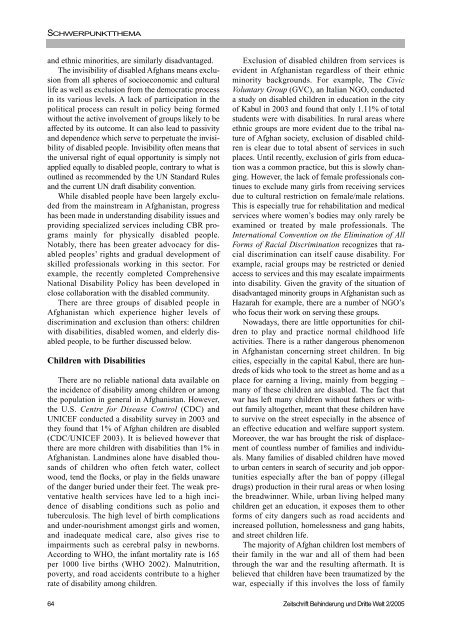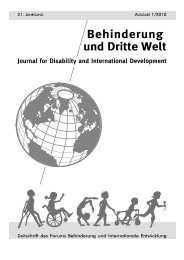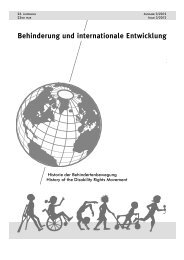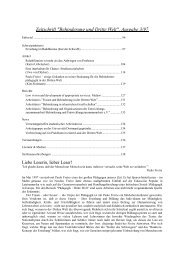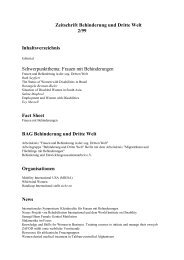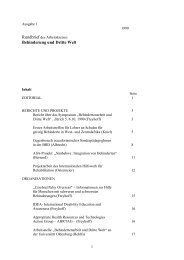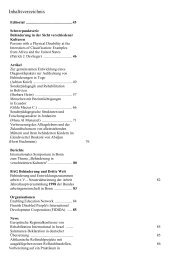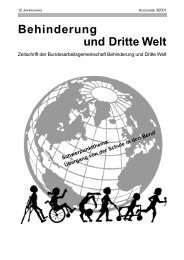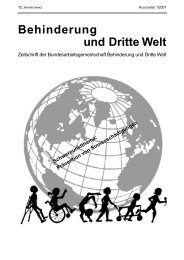Armut und Behinderung - Behinderung und Dritte Welt
Armut und Behinderung - Behinderung und Dritte Welt
Armut und Behinderung - Behinderung und Dritte Welt
You also want an ePaper? Increase the reach of your titles
YUMPU automatically turns print PDFs into web optimized ePapers that Google loves.
SCHWERPUNKTTHEMAand ethnic minorities, are similarly disadvantaged.The invisibility of disabled Afghans means exclusionfrom all spheres of socioeconomic and culturallife as well as exclusion from the democratic processin its various levels. A lack of participation in thepolitical process can result in policy being formedwithout the active involvement of groups likely to beaffected by its outcome. It can also lead to passivityand dependence which serve to perpetuate the invisibilityof disabled people. Invisibility often means thatthe universal right of equal opportunity is simply notapplied equally to disabled people, contrary to what isoutlined as recommended by the UN Standard Rulesand the current UN draft disability convention.While disabled people have been largely excludedfrom the mainstream in Afghanistan, progresshas been made in <strong>und</strong>erstanding disability issues andproviding specialized services including CBR programsmainly for physically disabled people.Notably, there has been greater advocacy for disabledpeoples’ rights and gradual development ofskilled professionals working in this sector. Forexample, the recently completed ComprehensiveNational Disability Policy has been developed inclose collaboration with the disabled community.There are three groups of disabled people inAfghanistan which experience higher levels ofdiscrimination and exclusion than others: childrenwith disabilities, disabled women, and elderly disabledpeople, to be further discussed below.Children with DisabilitiesThere are no reliable national data available onthe incidence of disability among children or amongthe population in general in Afghanistan. However,the U.S. Centre for Disease Control (CDC) andUNICEF conducted a disability survey in 2003 andthey fo<strong>und</strong> that 1% of Afghan children are disabled(CDC/UNICEF 2003). It is believed however thatthere are more children with disabilities than 1% inAfghanistan. Landmines alone have disabled thousandsof children who often fetch water, collectwood, tend the flocks, or play in the fields unawareof the danger buried <strong>und</strong>er their feet. The weak preventativehealth services have led to a high incidenceof disabling conditions such as polio andtuberculosis. The high level of birth complicationsand <strong>und</strong>er-nourishment amongst girls and women,and inadequate medical care, also gives rise toimpairments such as cerebral palsy in newborns.According to WHO, the infant mortality rate is 165per 1000 live births (WHO 2002). Malnutrition,poverty, and road accidents contribute to a higherrate of disability among children.64Exclusion of disabled children from services isevident in Afghanistan regardless of their ethnicminority backgro<strong>und</strong>s. For example, The CivicVoluntary Group (GVC), an Italian NGO, conducteda study on disabled children in education in the cityof Kabul in 2003 and fo<strong>und</strong> that only 1.11% of totalstudents were with disabilities. In rural areas whereethnic groups are more evident due to the tribal natureof Afghan society, exclusion of disabled childrenis clear due to total absent of services in suchplaces. Until recently, exclusion of girls from educationwas a common practice, but this is slowly changing.However, the lack of female professionals continuesto exclude many girls from receiving servicesdue to cultural restriction on female/male relations.This is especially true for rehabilitation and medicalservices where women’s bodies may only rarely beexamined or treated by male professionals. TheInternational Convention on the Elimination of AllForms of Racial Discrimination recognizes that racialdiscrimination can itself cause disability. Forexample, racial groups may be restricted or deniedaccess to services and this may escalate impairmentsinto disability. Given the gravity of the situation ofdisadvantaged minority groups in Afghanistan such asHazarah for example, there are a number of NGO’swho focus their work on serving these groups.Nowadays, there are little opportunities for childrento play and practice normal childhood lifeactivities. There is a rather dangerous phenomenonin Afghanistan concerning street children. In bigcities, especially in the capital Kabul, there are h<strong>und</strong>redsof kids who took to the street as home and as aplace for earning a living, mainly from begging –many of these children are disabled. The fact thatwar has left many children without fathers or withoutfamily altogether, meant that these children haveto survive on the street especially in the absence ofan effective education and welfare support system.Moreover, the war has brought the risk of displacementof countless number of families and individuals.Many families of disabled children have movedto urban centers in search of security and job opportunitiesespecially after the ban of poppy (illegaldrugs) production in their rural areas or when losingthe breadwinner. While, urban living helped manychildren get an education, it exposes them to otherforms of city dangers such as road accidents andincreased pollution, homelessness and gang habits,and street children life.The majority of Afghan children lost members oftheir family in the war and all of them had beenthrough the war and the resulting aftermath. It isbelieved that children have been traumatized by thewar, especially if this involves the loss of familyZeitschrift <strong>Behinderung</strong> <strong>und</strong> <strong>Dritte</strong> <strong>Welt</strong> 2/2005


